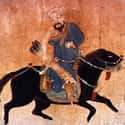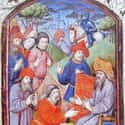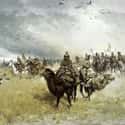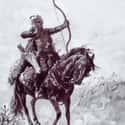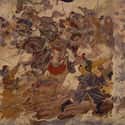-
(#1) Genghis Khan Conquered More Land Than Anyone In History
In only about 25 years, Genghis Khan managed to seize more land than the Roman Empire captured in over 400 years. As Mongol emperor, Genghis Khan conquered around 12 million square miles of land. He created the largest empire in history using just 100,000 men.
Under Genghis Khan, Mongol forces ended so many lives that fields went unplowed and the land reverted back to forests. In fact, climate scientists report that the depopulation was significant enough to actually cool the planet, because the trees absorbed so much carbon dioxide.
-
(#2) Though Destructive, They Established Safer And More Efficient Trade Along The Silk Road
The Mongols were incredibly destructive. During his conquests, Genghis Khan took an estimated 37.5 million lives; however, the Mongols also instituted an empire that unified much of Asia for the first time. Known as the Pax Mongolica, or "Mongol Peace," the Mongol domination let trade flourish on the Silk Road. For the first time, one power ruled the entire length of the Silk Road, making it much safer than ever before.
Trade flourished, and the Mongols boasted that a maiden carrying a gold nugget in her hand could cross from one end of the empire to the other without being harmed.
-
(#3) The Empire Helped Spread The Plague From Asia To Europe
The Plague originated in China when it was ruled by the Mongol Yuan Dynasty. Within three years of the disease's emergence, 90% of Hebei province's entire population had perished. Ironically, Mongol protection of Silk Road trade helped the disease spread.
The disease traveled with caravans to Middle Eastern trading centers, where Egyptian scholar Al-Mazriqi reported, "More than three hundred tribes all perished without apparent reason in their summer and winter encampments, in the course of pasturing their flocks and during their seasonal migration."
Along with the unintentional consequences of unfettered trade, the Mongols played an even more active role in spreading the disease. During a years-long siege of the Genoese-held city of Kaffa in 1347, the Mongol Golden Horde used germ warfare on the port city.
According to Italian lawyer Gabriele de Mussis, the Mongol leader "ordered corpses to be placed in catapults and lobbed into the city in hopes that the intolerable stench would [wipe out] everyone inside." The disease spread, and soon, "the [troops were] affected by a disease which overran the Tartars and [claimed] thousands upon thousands every day."
When the Genoese abandoned Kaffa to return to Italy, they carried the Plague with them.
-
(#4) They Invaded The Islamic World When The Shah Massacred Mongol Diplomats
Genghis Khan might have stopped his conquest at the border of the Khwarezmid Empire in modern Northeastern Iran, but it was only due to a slight by the empire's ruler that Genghis Khan continued to expand his territory. He sent a diplomatic message to Shah Ala ad-Din Muhammad that read, "I am master of the lands of the rising sun, while you rule those of the setting sun. Let us conclude a treaty of friendship and peace."
After accepting the treaty, the Shah wiped out a Mongol trade caravan in 1219. The Mongol ruler sent diplomats demanding restitution, but the Shah ended them and sent their heads back to the Great Khan. The Mongols responded by marching into Persia, taking out Shah Muhammad and completely conquering the Khwarezmid Empire.
While the Mongols were remarkably flexible about adopting bureaucracies and religions from conquered regions, they placed a high value on trade and law - and when the Shah took the lives of traders and diplomats, he was faced with the Mongol wrath.
-
(#5) Many Enemies Fell For The Mongols' Feigned Flight Tactic
Mongol tactics completely wiped out their adversaries. They relied on their small, sturdy horses, light armor, and archery. More mobile than any other fighting force at the time, the cavalry could cover up to 100 miles in a single day.
During skirmishes, the Mongols tricked their enemies by using a feigned retreat tactic. A small force of riders would charge the enemy, then break and flee. As the enemy advanced, the feigned flight would lead them into an ambush. The technique helped the Mongols conquer the largest land empire the world had ever seen.
-
(#6) They Embraced Religious Diversity Within Their Empire
As ruler, Genghis Khan declared religious freedom in his empire. Genghis Khan ruled over a religiously diverse territory that included Buddhists, Christians, and Muslims. Suppressing these religions would have only antagonized the new Mongol subject, so Genghis Khan promoted an official policy of religious tolerance. Within the empire, religious leaders were exempt from taxation, and all subjects could practice any religion.
In governing his massive empire, Genghis Khan relied on advisors who practiced multiple faiths. The Mongol capital city of Karakorum contained churches, mosques, lamaseries, and temples to cater to the faiths of all subjects.
-
(#7) Before Genghis Khan, The Mongols Were Contentious Nomadic Tribes
The stunning expansion of the Mongol Empire looked unlikely in its early years. The Central Asian steppe was divided into dozens of nomadic tribes that spent most of their time fighting each other. The steppe might have remained divided if it were not for the Great Khan.
Instead of promoting his own relatives, Genghis Khan used a meritocratic system to organize his tribe. He struck down enemy leaders and incorporated their followers into his own clan. By 1205, Genghis Khan had united the Mongol tribes under one rule and enforced new legislation. Mongols were no longer allowed to sell or capture women, enslave each other, or take livestock. Genghis Khan imposed a writing system, invited foreign ambassadors with diplomatic immunity, and granted religious freedom in his territory of one million people.
It was only after he consolidated Mongol and Tartar tribes of the Asian steppe that the Great Khan turned his attention to conquering China, Russia, Persia, and Europe.
-
(#8) Mongol Tactics Shook European Reliance On Heavy Cavalry
When the Mongols swept across Asia, conquering territory on their lightly armored horses, European knights might have initially sneered at their rivals. Medieval European forces favored heavy cavalry, with armored knights and powerful horses that often wore armor themselves. To the Europeans, the short, stubby Mongol horses weren't very impressive. In combat, however, the European knights quickly realized the advantages of the Mongols.
Mongol recurve bows could strike cavalry at an amazing distance under rough circumstances. Mongol riders used stirrups to fire arrows in any direction, even backward. The smaller horses could run circles around an armored knight, and the Mongols prioritized taking down European horses to leave the armored fighter on foot with little mobility.
-
(#9) They Established Multiple Successor States Around The World
The unified Mongol Empire barely outlived Genghis Khan. The ruler sent his four sons in four directions after conquering much of Asia: Jochi traveled north toward Russia and founded the Golden Horde, Tolui moved south toward Baghdad, Ogodei ruled the Mongol homelands, and Chagatai ruled in Central Asia.
Genghis Khan's grandson eventually ruled in China as Khubilai Khan, emperor of the Yuan Dynasty. These successor states increasingly adopted local practices. In the Middle East, the Il-Khanid Dynasty converted to Islam, and other Khanates, including the Chagatai Khanate, fragmented even further, ending the Pax Mongolica.
-
(#10) Defeating The Mongols Has Become A Source Of National Pride For Japan
In 1274 and 1281, Khubilai Khan invaded Japan with his Mongol forces. Despite the thousands of ships and over 100,000 men that crossed the East China Sea to capture Japan, the Empire of Japan somehow survived.
In both cases, typhoons struck the Mongol ships, wiping out their forces. According to legend, the Emperor of Japan called upon the typhoons, which they called kamikaze or "divine winds." After two massive defeats, Khubilai Khan called off the invasion.
Despite doubt by many historians and claims that the stories may have been Japanese propaganda during WWII, recent archeological research has established that two massive typhoons did strike in the 13th century.
-
(#11) Mongol Rule Pushed Ming China To Reject Outside Influences
When the Mongols conquered China, they established the Yuan Dynasty and pushed for harsh measures against the Chinese. Contrary to pre-Yuan rule, the Chinese were treated as second class citizens. Advisors were brought in from across the Mongolian Empire; no longer did the ethnic Chinese have control of their own country. Instead, foreigners made up the imperial court, held civil offices, and led troops. New laws were put in place to weaken Chinese unity and lessen the threat of rebellion. These included confiscating Chinese arms and imposing segregation between the Mongols and the Chinese.
In 1370, a long-brewing rebellion against the Yuan Dynasty established a new, Chinese dynasty: the Ming dynasty. The early Ming dynasty promoted strength and preparedness to prevent a Mongol reconquest. China also pushed traditional methods, cutting off much of the trade promoted by the Mongols and turning towards isolationism.
-
(#12) The Mongols Inspired European Explorers
During the Pax Mongolica, international trade flourished. For the first time, a single power governed the Silk Road, making it cheaper and less dangerous than ever before. For the first time, a large number of European merchants traveled the Silk Road.
One of them, Marco Polo, met Mongol ruler Khubilai Khan and reported back to Europe with tales of the riches of the East. Marco Polo's writings became so popular they inspired European explorers to find new routes to China once the collapse of the Mongol Empire made the Silk Road dangerous again. In fact, Christopher Columbus reportedly carried a copy of Marco Polo's Travels on his transatlantic voyage.
New Random Displays Display All By Ranking
About This Tool
In the 13th century AD, Genghis Khan established a huge Mongolian Empire extending east to Northeast Asia, west to Central Asia and part of the Middle East, and south to the Indian Peninsula. In the historical narrative, the civilization where the Mongolian cavalry went was destroyed, and Mongolia was portrayed as a predatory and brutal conqueror in history. Many historians have been discussing whether the Mongolian Empire was the destroyer of civilization or the pioneer of globalization?
The Mongolian Empire expanded the territory crazily in a short period of time, Genghis Khan promoted Eurasian cultural exchanges, and the successive disintegration of Mongolian Khanates also prompted the emergence of a new Eurasian world. The random tool shares 12 things about how the Mongol Empire destroyed and improved the world.
Our data comes from Ranker, If you want to participate in the ranking of items displayed on this page, please click here.















